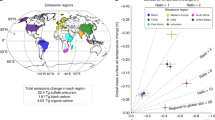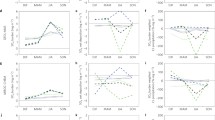Abstract
Climate sensitivity and aerosol forcing are dominant uncertain properties of the global climate system. Their estimates based on the inverse approach are interdependent as historical temperature records constrain possible combinations. Nevertheless, many literature projections of future climate are based on the probability density of climate sensitivity and an independent aerosol forcing without considering the interdependency of such estimates. Here we investigate how large such parameter interdependency affects the range of future warming in two distinct settings: one following the A1B emission scenario till the year 2100 and the other assuming a shutdown of all greenhouse gas and aerosol emissions in the year 2020. We demonstrate that the range of projected warming decreases in the former case, but considerably broadens in the latter case, if the correlation between climate sensitivity and aerosol forcing is taken into account. Our conceptual study suggests that, unless the interdependency between the climate sensitivity and aerosol forcing estimates is properly considered, one could underestimate a risk involving the “climate trap”, an unpalatable situation with a high climate sensitivity in which a very drastic mitigation may counter-intuitively accelerate the warming by unmasking the hidden warming due to aerosols.


Similar content being viewed by others
References
Andreae MO, Jones CD, Cox PM (2005) Strong present-day aerosol cooling implies a hot future. Nature 435:1187–1190. doi:10.1038/nature03671
Archer D, Eby M, Brovkin V, Ridgwell A, Cao L, Mikolajewicz U, Caldeira K, Matsumoto K, Munhoven G, Montenegro A, Tokos K (2009) Atmospheric lifetime of fossil fuel carbon dioxide. Annu Rev Earth Planet Sci 37:117–134. doi:10.1146/annurev.earth.031208.100206
Armour KC, Roe GH (2011) Climate commitment in an uncertain world. Geophys Res Lett 38:L01707. doi:10.1029/2010GL045850
Bender FA-M (2008) A note on the effect of GCM tuning on climate sensitivity. Environ Res Lett 3:014001. doi:10.1088/1748-9326/3/1/014001
Brasseur GP, Roeckner E (2005) Impact of improved air quality on the future evolution of climate. Geophys Res Lett 32:L23704. doi:10.1029/2005GL023902
Caldeira K, Jain A, Hoffert M (2003) Climate sensitivity uncertainty and the need for energy without CO2 emission. Science 299:2052–2054. doi:10.1126/science.1078938
Chylek P, Lohmann U, Dubey M, Mishchenko M, Kahn R, Ohmura A (2007) Limits on climate sensitivity derived from recent satellite and surface observations. J Geophys Res 112:D24S04. doi:10.1029/2007JD008740
Forest CE, Stone PH, Sokolov AP, Allen MR, Webster MD (2002) Quantifying uncertainties in climate system properties with the use of recent climate observations. Science 295:113–117. doi:10.1126/science.1064419
Frame DJ, Booth BBB, Kettleborough JA, Stainforth DA, Gregory JM, Collins M, Allen MR (2005) Constraining climate forecasts: the role of prior assumptions. Geophys Res Lett 32:L09702. doi:10.1029/2004GL022241
Frölicher TL, Joos F (2010) Reversible and irreversible impacts of greenhouse gas emissions in multi-century projections with the NCAR global coupled carbon cycle-climate model. Clim Dyn 35:1439–1459. doi:10.1007/s00382-009-0727-0
Haerter JO, Roeckner E, Tomassini L, von Storch J-S (2009) Parametric uncertainty effects on aerosol radiative forcing. Geophys Res Lett 36:L15707. doi:10.1029/2009GL039050
Hansen J et al (2005) Efficacy of climate forcings. J Geophys Res 110:D18104. doi:10.1029/2005JD005776
Hare B, Meinshausen M (2006) How much warming are we committed to and how much can be avoided? Clim Change 75:111–149. doi:10.1007/s10584-005-9027-9
Harvey LDD, Kaufmann RK (2002) Simultaneously constraining climate sensitivity and aerosol radiative forcing. J Climate 15:2837–2861. doi:10.1175/1520-442(2002) 015%3C2837:SCCSAA%3E2.0.CO;2
IPCC (2000) In: Nakićenović N, Swart R (eds) Special report on emissions scenarios: a special report of working group III of the intergovernmental panel on climate change. Cambridge Univ. Press, UK
IPCC (2001) Climate change 2001: the scientific basis. In: Houghton JT, Ding Y, Griggs DJ, Noguer M, van der Linden PJ, Dai X, Maskell K, Johnson CA (eds) Contribution of working group I to the third assessment report of the intergovernmental panel on climate change. Cambridge University Press, Cambridge and New York, p 881
IPCC (2007) Climate change 2007: the physical science basis. In: Solomon S, Qin D, Manning M, Chen Z, Marquis M, Averyt KB, Tignor M, Miller HL (eds) contribution of working group I to the fourth assessment report of the intergovernmental panel on climate change. Cambridge University Press, Cambridge, United Kingdom and New York, NY, USA, p 996
Johansson D (2011) Temperature stabilization, ocean heat uptake and radiative forcing overshoot profiles. Clim Change 108:107–134. doi:10.1007/s10584-010-9969-4
Joos F, Prentice C, Sitch S, Meyer R, Hooss G, Plattner G-K, Gerber S, Hasselmann K (2001) Global warming feedbacks on terrestrial carbon uptake under the Intergovernmental Panel on Climate Change (IPCC) emission scenarios. Glob Biogeochem Cycles 15:891–907. doi:10.1029/2000GB001375
Kerr RA (2007) Another global warming icon comes under attack. Science 317:28–29. doi:10.1126/science.317.5834.28a
Kiehl JT (2007) Twentieth century climate model response and climate sensitivity. Geophys Res Lett 34:L22710. doi:10.1029/2007GL031383
Knutti R (2008) Why are climate models reproducing the observed global surface warming so well? Geophys Res Lett 35:L18704. doi:10.1029/2008GL034932
Knutti R, Hegerl GC (2008) The equilibrium sensitivity of the Earth’s temperature to radiation changes. Nat Geosci 1:735–743. doi:10.1038/ngeo337
Knutti R, Stocker TF, Joos F, Plattner G-K (2002) Constraints on radiative forcing and future climate change from observations and climate model ensembles. Nature 416:719–723. doi:10.1038/416719a
Knutti R, Allen MR, Friedlingstein P, Gregory JM, Hegerl GC, Meehl GA, Meinshausen M, Murphy JM, Plattner G-K, Raper SCB, Stocker TF, Stott PA, Teng H, Wigley TML (2008) A review of uncertainties in global temperature projections over the twenty-first century. J Climate 21:2651–2663. doi:10.1175/2007JCLI2119.1
Kriegler E (2005) Imprecise probability analysis for integrated assessment of climate change. PhD dissertation, Potsdam Universität, p. 258. http://www.pik-potsdam.de/~kriegler/
Mackenzie FT, Lerman A (2006) Carbon in the geobiosphere: earth’s outer shell. Springer, Dordrecht, p 402
Matthews HD, Weaver AJ (2010) Committed climate warming. Nat Geosci 3:142–143. doi:10.1038/ngeo813
Meinshausen M et al (2009) Greenhouse-gas emission targets for limiting global warming to 2°C. Nature 458:1158–1162. doi:10.1038/nature08017
Moss RH et al (2010) The next generation of scenarios for climate change research and assessment. Nature 463:747–756. doi:10.1038/nature08823
Murphy JM, Sexton DMH, Barnett DN, Jones GS, Webb MJ, Collins M, Stainforth DA (2004) Quantifying uncertainty in model predictions. Nature 430:768–772. doi:10.1038/nature02771
Penner JE, Prather MJ, Isaksen ISA, Fuglestvedt JS, Klimont Z, Stevenson DS (2010) Short-lived uncertainty? Nat Geosci 3:587–588. doi:10.1038/ngeo932
Plattner G-K et al (2008) Long-term climate commitments projected with climate–carbon cycle models. J Climate 21:2721–2751. doi:10.1175/2007JCLI1905.1
Ramanathan V, Feng Y (2008) On avoiding dangerous anthropogenic interference with the climate system: formidable challenges ahead. PNAS 105:14245–14250. doi:10.1073/pnas.0803838105
Rive N, Torvanger A, Berntsen T, Kallbekken S (2007) To what extent can a long-term temperature target guide near-term climate change commitments? Clim Change 82:373–391. doi:10.1007/s10584-006-9193-4
Roe GH, Baker MB (2007) Why is climate sensitivity so unpredictable? Science 318:629–632. doi:10.1126/science.1144735
Schwartz SE, Charlson RJ, Rodhe H (2007) Quantifying climate change—too rosy a picture? Nature Reports. Clim Change 2:23–24. doi:10.1038/climate.2007.22
Sokolov AP, Stone PH, Forest CE, Prinn R, Sarofim MC, Webster M, Paltsev S, Schlosser CA, Kicklighter D, Dutkiewicz S, Reilly J, Wang C, Felzer B, Melillo JM, Jacoby HD (2009) Probabilistic forecast for twenty-first-century climate based on uncertainties in emissions (Without Policy) and climate parameters. J Climate 22:5175–5204. doi:10.1175/2009JCLI2863.1
Solomon S, Plattner G-K, Knutti R, Friedlingstein P (2009) Irreversible climate change due to carbon dioxide emissions. PNAS 106:1704–1709. doi:10.1073/pnas.0812721106
Solomon S, Daniel JS, Sanford TJ, Murphy DM, Plattner G-K, Knutti R, Friedlingstein P (2010) Persistence of climate changes due to a range of greenhouse gases. PNAS 107:18354–18359. doi:10.1073/pnas.1006282107
Tanaka K (2008) Inverse estimation for the simple earth system model ACC2 and its applications. PhD dissertation, Hamburg Universität, International Max Planck Research School on Earth System Modelling, Hamburg, p. 296. http://www.sub.uni-hamburg.de/opus/volltexte/2008/3654/
Tanaka K, Kriegler E, Bruckner T, Hooss G, Knorr W, Raddatz T (2007) Aggregated carbon cycle, atmospheric chemistry, and climate model (ACC2): description of the forward and inverse modes. Reports on earth system science, no 40. Max Planck Institute for Meteorology, p. 188. http://www.mpimet.mpg.de/wissenschaft/publikationen/erdsystemforschung.html
Tanaka K, O’Neill BC, Rokityanskiy D, Obersteiner M, Tol RSJ (2009a) Evaluating global warming potentials with historical temperature. Clim Change 96:443–466. doi:10.1007/s10584-009-9566-6
Tanaka K, Raddatz T, O’Neill BC, Reick CH (2009b) Insufficient forcing uncertainty underestimates the risk of high climate sensitivity. Geophys Res Lett 36:L16709. doi:10.1029/2009GL039642
Urban NM, Keller K (2010) Probabilistic hindcasts and projections of the coupled climate, carbon cycle and Atlantic meridional overturning circulation system: a Bayesian fusion of century-scale observations with a simple model. Tellus A 62:737–750. doi:10.1111/j.1600-0870.2010.00471.x
Wigley TML (1991) Could reducing fossil-fuel emissions cause global warming? Nature 349:503–506. doi:10.1038/349503a0
Wigley TML, Raper SCB (2001) Interpretation of high projections for global-mean warming. Science 293:451–454. doi:10.1126/science.1061604
Acknowledgments
Comments by Kyle Armour, Terje Berntsen, Andreas Chlond, Reto Knutti, Nathan Rive, and several anonymous reviewers at various stages are very useful to refine the paper. K. Tanaka is supported by the IIASA Postdoctoral Fellowship, the Norwegian Research Council under project 184840/S30 (CLIMSENS—Constraining total feedback of the climate system by observations and models), and the Marie Curie Intra-European Fellowship within the 7th European Community Framework Programme (Proposal N° 255568 under FP7-PEOPLE-2009-IEF).
Conflict of interests
The authors declare no competing financial interests
Author information
Authors and Affiliations
Corresponding author
Rights and permissions
About this article
Cite this article
Tanaka, K., Raddatz, T. Correlation between climate sensitivity and aerosol forcing and its implication for the “climate trap”. Climatic Change 109, 815–825 (2011). https://doi.org/10.1007/s10584-011-0323-2
Received:
Accepted:
Published:
Issue Date:
DOI: https://doi.org/10.1007/s10584-011-0323-2




